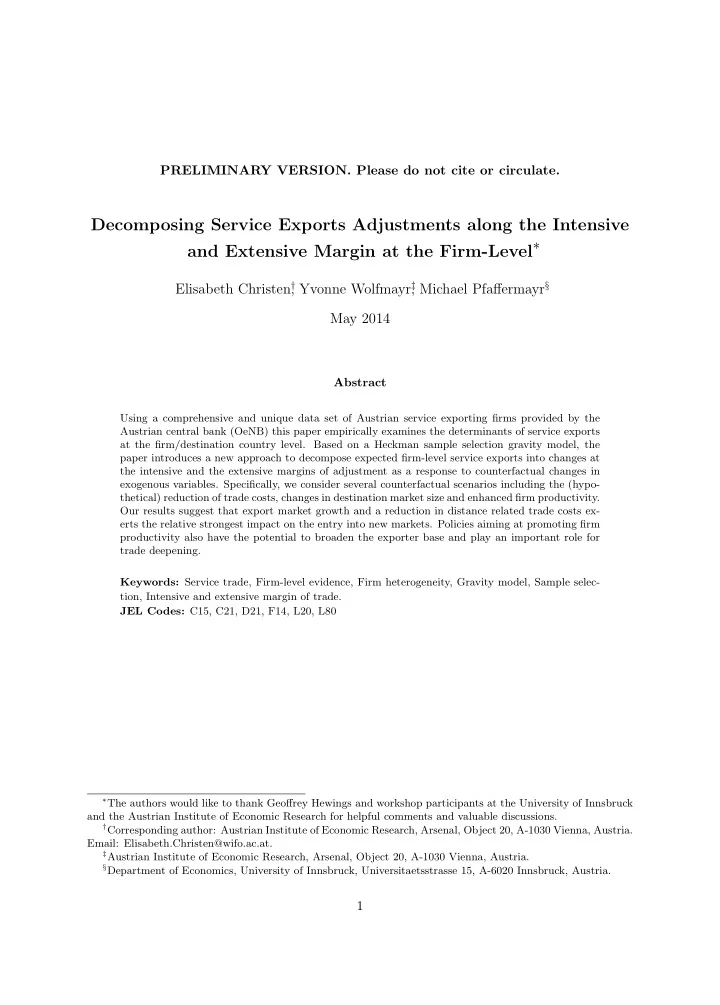

PRELIMINARY VERSION. Please do not cite or circulate. Decomposing Service Exports Adjustments along the Intensive and Extensive Margin at the Firm-Level ∗ Elisabeth Christen † , Yvonne Wolfmayr ‡ , Michael Pfaffermayr § May 2014 Abstract Using a comprehensive and unique data set of Austrian service exporting firms provided by the Austrian central bank (OeNB) this paper empirically examines the determinants of service exports at the firm/destination country level. Based on a Heckman sample selection gravity model, the paper introduces a new approach to decompose expected firm-level service exports into changes at the intensive and the extensive margins of adjustment as a response to counterfactual changes in exogenous variables. Specifically, we consider several counterfactual scenarios including the (hypo- thetical) reduction of trade costs, changes in destination market size and enhanced firm productivity. Our results suggest that export market growth and a reduction in distance related trade costs ex- erts the relative strongest impact on the entry into new markets. Policies aiming at promoting firm productivity also have the potential to broaden the exporter base and play an important role for trade deepening. Keywords: Service trade, Firm-level evidence, Firm heterogeneity, Gravity model, Sample selec- tion, Intensive and extensive margin of trade. JEL Codes: C15, C21, D21, F14, L20, L80 ∗ The authors would like to thank Geoffrey Hewings and workshop participants at the University of Innsbruck and the Austrian Institute of Economic Research for helpful comments and valuable discussions. † Corresponding author: Austrian Institute of Economic Research, Arsenal, Object 20, A-1030 Vienna, Austria. Email: Elisabeth.Christen@wifo.ac.at. ‡ Austrian Institute of Economic Research, Arsenal, Object 20, A-1030 Vienna, Austria. § Department of Economics, University of Innsbruck, Universitaetsstrasse 15, A-6020 Innsbruck, Austria. 1
1 Introduction The (new) new trade theory literature pioneered by Melitz (2003) and further developed by Chaney (2008), Helpman et al. (2008) and Crozet and Koenig (2010) emphasizes the self- selection of the more productive firms into export destination markets. As firms exhibit het- erogeneity in their productivity, only the more productive and larger firms are able to earn sufficient positive operating profits in a destination market to cover the associated fixed costs and thus serve this market by exports. At the firm level, adjustments in trade flows due to changes in exogenous determinants occur along two margins. On the one hand firms entering (exiting) a specific destination market contribute to an increase (decrease) in exports to that market (the extensive margin). On the other hand firms that already export to a destination may increase or decrease their export activities (the intensive margin). Both margins of ad- justment, and especially their relative contributions to overall export growth, seem to be highly relevant to economic policy as different policy instruments are relevant to promote firms to enter new foreign markets and to deepen existing export relations. Despite the prominent role gravity models have had in explaining aggregate trade flows, their adoption to firm level data has not yet gained widespread attention in the empirical literature, even less so for service trade. Greenaway et al. (2009) apply a Heckman sample selection gravity model to control for the possible self-selection into exporting using firm level data on the Swedish food and beverage sector. Their findings are consistent with the predictions from the theory and confirm that more productive and larger firms are more likely to serve large and relatively close foreign markets. Additionally, also the export volumes are positively influenced by the size of the destination market and negatively by the distance between the trading partners. In a related paper, Crozet and Koenig (2010) examine the impact of distance on the probability of exporting and the export levels using French manufacturing firm level data. Their results show that distance has a significant negative impact on both the propensity to export and the export volume in the majority of the industries. 1 . In contrast to the research on goods trade, the empirical literature on services trade is developing only recently and so far mainly relies on aggregate data. 2 Recent contributions on services trade using firm-level data include Breinlich and Criscuolo (2011) who are among the first to study firm-level services trade with a focus one trade participation and trade patterns of UK firms. In line with the evidence for manufacturing firms they find important differences between service traders and non-traders with respect to firm size and productivity. A major conclusion of their study is that firm-heterogeneity is also a key feature of services trade, thereby pointing to the relevance of heterogenous firm models for modeling service activities. In related papers Kelle and Kleinert (2010), Ariu (2011, 2012) and Federico and Tosti (2012) report similar stylized facts and provide firm-level evidence on services trade for Germany, Belgium and Italy, respectively. All these contributions distinguish between the adjustment at the intensive and extensive margin at the aggregate levels of destinations or industries. Accordingly, variations in aggregated firm-level services trade are mainly explained by the intensive margin, while contributions of the extensive margin only account for 20 to 30% of total variation. This 1 A detailed survey on the export productivity nexus at the firm-level is provided by Wagner (2007) but the survey does not include gravity models. 2 Francois and Hoekman (2010) provide a comprehensive survey on service trade. 2
Recommend
More recommend